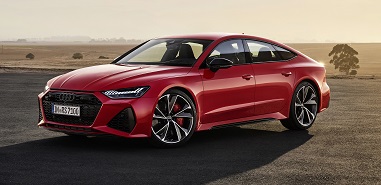

Liftback, 4 Doors, 5 Seats
11.4-11.6 l/100 km 20.63 - 20.28 US mpg
16.1 l/100 km 14.61 US mpg
8.7 l/100 km 27.04 US mpg
600 Hp @ 6000-6250 rpm.
150.2 Hp/l
250 km/h 155.34 mph
3996 cm3
243.85 cu. in.
8, V-engine
All wheel drive (4x4),
5009 mm
197.2 in.
1950 mm
76.77 in.
2065 kg
4552.55 lbs.
| Brand | Audi |
|---|---|
| Model | RS 7 (Liftback) |
| Version | RS 7 Sportback (C8) |
| Engine version | 4.0 TFSI V8 (600 Hp) quattro tiptronic MHEV |
| Year production start | 2019 |
| Vehicle type | Liftback |
| Horsepower RPM | 600 Hp @ 6000-6250 rpm. |
| Acceleration 0 - 100 kmh sec | 3.6 sec |
| Curb weight kg -lbs total |
2065 kg4552.55 lbs. |
| Overall length mm - inch |
5009 mm197.2 in. |
| Doors | 4 |
| Top Speed | 250 km/h 155.34 mph |
| Designation model | DJP |
|---|---|
| Engine position and orientation | Front, Longitudinal |
| Cylinders | 8 |
| Position of cylinders | V-engine |
| Displacement (liters) |
3996 cm3243.85 cu. in. |
| Eng. horsepower RPM | 600 Hp @ 6000-6250 rpm. |
| Horsepower per litre | 150.2 Hp/l |
| Weight / horsepower kg/hp - hp/tons |
3.4 kg/Hp290.6 Hp/tonne |
| Weight / torque kg/Nm - Nm/tons | 2.6 kg/Nm, 387.4 Nm/tonne
2.6 kg/Nm387.4 Nm/tonne |
| Torque Nm RPM lb-ft RPM |
800 Nm @ 2050-4500 rpm.590.05 lb.-ft. @ 2050-4500 rpm. |
| Fuel delivery system | Direct injection |
| Fuel type | Petrol (Gasoline) |
| Valvetrain | 4 |
| Engine aspiration | Twin-Turbo, Intercooler |
| Engine oil liters | quarts |
9.5 l10.04 US qt | 8.36 UK qt |
| Engine coolant |
12.1 l12.79 US qt | 10.65 UK qt |
| Emission certification | Euro 6d-TEMP-EVAP-ISC |
| Powertrain architecture | MHEV (Mild Hybrid Electric Vehicle, power-assist hybrid, battery-assisted hybrid vehicles, BAHV) |
| Engine location | Front, Longitudinal |
| Drive configuration | All wheel drive (4x4) |
|---|
| Front brakes | Ventilated discs, 420 mm |
|---|---|
| Rear brakes | Ventilated discs, 420 mm |
| Brake control | Ventilated discs, 370 mm |
| Anti-lock brake system | ABS (Anti-lock braking system) |
| Steering type | Steering rack and pinion |
|---|
| Front suspension | Multi-link suspension |
|---|---|
| Rear suspension | Multi-link independent |
| Wheels size | 275/35 ZR21 103XL |
|---|---|
| Wheels rims | 10.5J x 21 |
| Passengers seats | 5 |
|---|---|
| Trunk space min liter | cu. Ft. |
535 l18.89 cu. ft. |
| Trunk space max liter | cu. Ft. |
1390 l49.09 cu. ft. |
| Roof load load kg lbs |
90 kg198.42 lbs. |
| Overall length mm - inch |
5009 mm197.2 in. |
|---|---|
| Overall width mm -inch |
1950 mm76.77 in. |
| Overall height mm -inch |
1424 mm56.06 in. |
| Wheelbase mm - inch |
2930 mm115.35 in. |
| Track width front mm - inch |
1668 mm65.67 in. |
| Track width rear mm - inch |
1650 mm64.96 in. |
| Curb weight kg -lbs total |
2065 kg4552.55 lbs. |
|---|---|
| Gross weight kg -lbs total |
2735 kg6029.64 lbs. |
| Capacities kg - lbs |
670 kg1477.1 lbs. |
| Fuel tank liters | gallons |
73 l19.28 US gal | 16.06 UK gal |
| City l/100km - mpg |
16.1 l/100 km14.61 US mpg |
|---|---|
| Highway l/100 km - mpg |
8.7 l/100 km27.04 US mpg |
| Combined l/100 km - Mpg |
11.4-11.6 l/100 km20.63 - 20.28 US mpg |
| Autonomy km (combined use) | 664 |
| Combined fuel consumption (WLTP) | 12.2-12.7 l/100 km 19.28 - 18.52 US mpg |
8 CYLINDER V-Engine
https://www.thecarspec.net/components/engine/8-cylinders-v